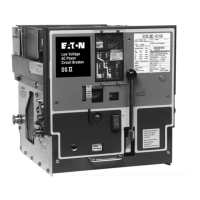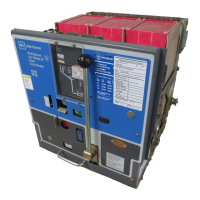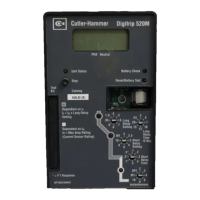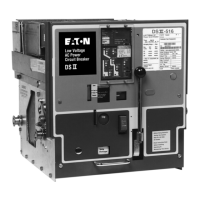I.
B.
694C694-02
Position
Trip
Actuator
Latch Not
Figure 3-17 Latch Check Switch Operation
c
As the breaker opens, a pin on the left pole unit shaft
strikes a vertical leg (reset arm) of the undervoltage trip-
ping lever and rotates it counterclockwise against its tor-
sion spring. Another arm
on
the tripping lever resets the
roller latch and moving core. A slight amount of over-
travel on the trip latch insures positive resetting under all
conditions.
The undervoltage trip attachment is bolted
in
place in
the lower circuit breaker chassis. Always connect the
undervoltage coil on the line side of the breaker unless
the attachment is equipped with a time delay device.
In
this case, the time delay will delay tripping of the break-
er
long enough to permit energization of the undervolt-
age coil from the load side. Do not use an auxiliary
switch contact
in
the undervoltage circuit.
3-10.8 OVERCURRENT TRIP SWITCH
The overcurrent trip switch is optional on both manually
and power operated breakers. Its function is to provide a
signal to indicate that the breaker has tripped open by
action of the electronic trip unit due to phase
or
ground
overcurrent. Tripping by the trip plate, shunt trip device,
undervoltage trip device and other such methods does
not cause it to operate.
Effective
07
/97
Page
21
Breaker Open
Position
Pole
Shaft
Trip Bar
Breaker
Closed
Breaker Closed
Position
Figure 3-18 Undervoltage Trip Attachment Operation
It is mounted on and operates from the trip actuator of
the breaker. Three standard contact arrangements are
available: (1) two normally open, (2) two normally
closed,
or
(3) one normally open and one normally
closed. These are independently wired to breaker sec-
ondary disconnect contacts. Special units may have one
additional contact.
The device is latch-type and must be manually reset by
means of a pushbutton mounted on the breaker front
panel. An electric reset type is available for remote
operation (Figure 3-19).
3-11
MISCELLANEOUS DETAILS
3-11.1 INTERFERENCE INTERLOCK
A "Z" shaped bracket prevents a circuit breaker with an
insufficient interrupting rating
or
mismatched discon-
nects from being inserted into the wrong compartment
(Figure 3-14). The breaker mounted bracket has to
properly key with a bracket mounted on the compart-
ment floor to permit breaker insertion (Table
3.1
).
An
interference interlock bracket is standard
on
all drawout
circuit breakers.
Courtesy of NationalSwitchgear.com

